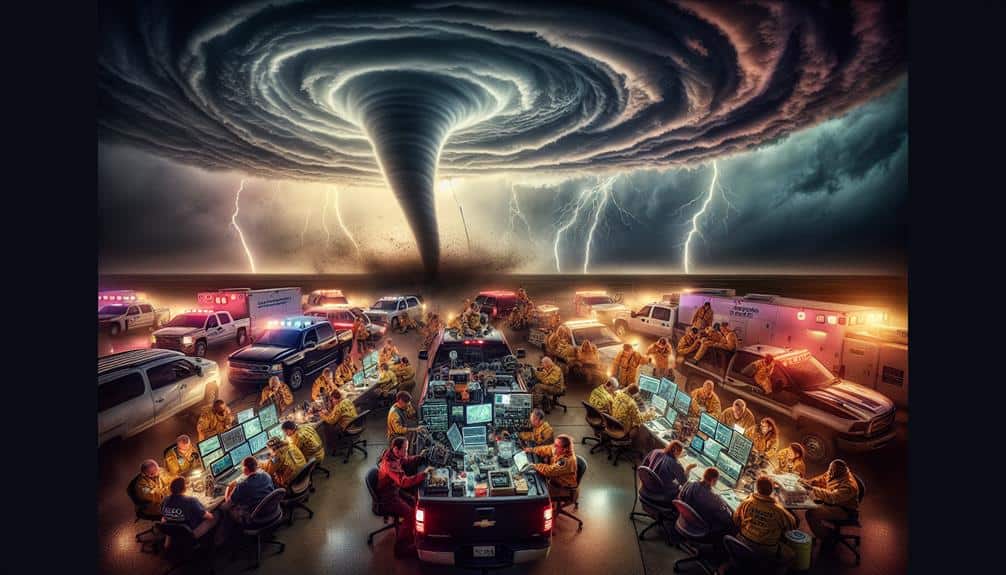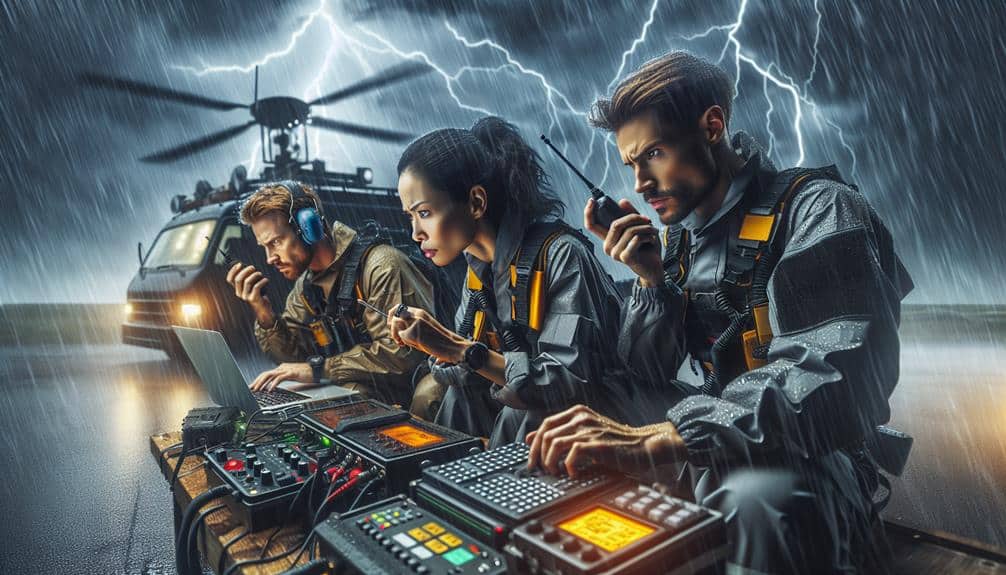We strengthen emergency coordination by actively involving our community in preparedness and response efforts. By fostering local partnerships and transparent communication, we make sure everyone is engaged and informed. Training community volunteers with essential skills through hands-on simulations builds a well-coordinated response network. Efficient communication channels that leverage social media and mobile apps enable real-time information sharing. Strategic resource allocation, involving residents and community leaders, maximizes our response capability. Collaboration in planning and recovery efforts harnesses local expertise and enhances trust. This inclusive strategy empowers our community, making us better prepared for emergencies; discover how we execute these initiatives.
Key Points
- Foster strong local partnerships to ensure seamless coordination during emergencies.
- Utilize transparent communication channels to keep the community well-informed and involved.
- Train and empower community volunteers to enhance emergency response capabilities.
- Leverage digital platforms and social media networks for real-time information sharing.
Building Local Awareness
Building local awareness is important for ensuring that our community is prepared to respond effectively in emergencies. To achieve this, we need to foster strong local partnerships and encourage active community engagement. By collaborating with local businesses, schools, and civic organizations, we can create a network that's both informed and ready to act when the need arises.
We should focus on transparent communication channels to keep everyone in the loop. Regular meetings and social media groups can serve as platforms for sharing essential information and updates. This approach guarantees that all stakeholders understand their roles and responsibilities during a crisis. Additionally, these partnerships can leverage resources and expertise that individual entities might lack, thereby strengthening our overall emergency response capabilities.
Community engagement is equally important. When residents feel involved and valued, they're more likely to participate in preparedness activities. Hosting local events, workshops, and drills can educate the public and build a sense of collective responsibility. This not only raises awareness but also empowers individuals by providing them with the knowledge and skills they need to act decisively and independently.
Ultimately, building local awareness through robust partnerships and active community engagement lays the foundation for a resilient and self-reliant community.
Training Community Volunteers
Training community volunteers is vital for enhancing our emergency response capabilities and ensuring a well-coordinated effort during crises. By equipping volunteers with the right skills, we can build a resilient community ready to act efficiently when it matters most.
Hands-on simulations are a pivotal component of this training. They immerse volunteers in realistic scenarios where they can practice essential skills under pressure. These simulations bridge the gap between theoretical knowledge and real-world application, making sure our community members are prepared for various emergency situations.
In addition to hands-on simulations, team building exercises play an indispensable role in fostering collaboration and trust among volunteers. When individuals understand how to work effectively within a team, they can coordinate better, leading to more effective and timely responses during emergencies. These exercises also help volunteers learn to communicate clearly, delegate tasks, and support each other under stress.
Effective Communication Channels
We must establish effective communication channels to guarantee real-time information sharing and streamlined alert systems during emergencies.
By integrating these systems, we can quickly disseminate critical updates and instructions to the community.
This will enhance our overall coordination and response efforts, ultimately saving lives.
Real-Time Information Sharing
Leveraging digital platforms and social media networks, communities can ensure real-time information sharing during emergencies, facilitating swift and coordinated responses. By tapping into crowdsourced data, we can harness the collective knowledge and observations of community members. This data can be invaluable for identifying issues quickly, such as blocked evacuation routes or available resources, thereby enhancing our response capabilities.
Community engagement is vital in this process. When we actively involve residents in data sharing, we create a more resilient and informed society. People on the ground can provide immediate updates, which are often more current than official reports. This real-time information allows us to adapt our strategies on the fly, ensuring that aid reaches those who need it most.
Furthermore, effective communication channels, such as dedicated social media groups and mobile apps, empower individuals to contribute to the emergency response actively. These platforms not only disseminate information but also foster a sense of solidarity and collective responsibility.
As we embrace these digital tools, we're not just sharing information; we're building a network of informed, engaged citizens ready to act when disaster strikes. This approach maximizes our collective freedom to respond effectively and efficiently.
Streamlined Alert Systems
Streamlined alert systems are necessary for ensuring timely and accurate communication during emergencies. When we talk about improving our response to crises, the efficiency of our alert systems is pivotal. These systems must be capable of delivering real-time updates to every member of the community, ensuring that essential information reaches everyone without delay.
To achieve this, we need to leverage modern technology and prioritize community engagement. By involving the community in the development and implementation of these alert systems, we can tailor them to meet local needs more effectively. This engagement fosters a sense of ownership and responsibility among community members, making them more likely to respond promptly and appropriately during emergencies.
Moreover, integrating multiple communication channels—SMS, social media, public broadcasts, and dedicated apps—ensures that alerts reach a wider audience. We can't rely on a one-size-fits-all approach; different people prefer different modes of communication. By diversifying our alert systems, we can markedly improve our response times and overall coordination.
Ultimately, streamlined alert systems not only enhance our emergency response but also empower the community. When everyone is informed and engaged, we can face emergencies with greater resilience and confidence.
Resource Allocation Strategies
In our efforts to enhance emergency coordination, we need to focus on efficient resource distribution. By strategically allocating resources, we can guarantee timely support where it's needed most.
Leveraging volunteer engagement and utilizing advanced technology will further streamline our response and recovery processes.
Efficient Resource Distribution
Effective resource allocation hinges on our ability to strategically assign assets where they're needed most during emergencies. By mastering resource management and leveraging community engagement, we ensure that our efforts are both efficient and impactful.
Resource management involves identifying critical supplies and making sure they're distributed swiftly and equitably. It's crucial to have a clear inventory and a well-coordinated distribution plan that can be activated immediately.
Community engagement plays a pivotal role in this process. When we involve local stakeholders, we gain valuable insights into the specific needs of different areas. This grassroots approach helps us tailor our resource allocation strategies to be more responsive and adaptive. By collaborating with community leaders and residents, we build a network of informed individuals who can assist in both the identification and delivery of resources.
Moreover, technology can greatly enhance our resource distribution efforts. Utilizing data analytics and real-time tracking systems allows us to monitor the flow of supplies accurately and make adjustments as needed. This ensures that no area is overlooked and resources are used efficiently.
Essentially, our ability to combine strategic planning, community input, and technological tools will determine the success of our emergency response initiatives.
Volunteer Engagement Tactics
To further improve our resource allocation strategies, let's explore how involving volunteers can greatly strengthen our emergency response efforts. Effective volunteer recruitment is vital for community empowerment and ensuring a strong response mechanism. By mobilizing community members, we can tap into local knowledge and skills that might otherwise be overlooked. This not only optimizes our resources but also fosters a sense of ownership and responsibility among residents.
Our engagement strategies should focus on creating clear, actionable roles for volunteers. Providing specific training sessions and resources ensures they're prepared for diverse emergency scenarios. Additionally, establishing a communication network allows for rapid mobilization and coordination, guaranteeing that volunteer efforts are both efficient and effective.
Community mobilization is at the heart of these tactics. By organizing regular community meetings and workshops, we can identify potential volunteers and build a strong, interconnected network. This proactive approach facilitates swift action when emergencies arise, leveraging collective strength.
Ultimately, integrating volunteers into our emergency response framework not only improves resource allocation but also strengthens communal bonds. By empowering individuals through active participation, we create a resilient and self-reliant community ready to face any challenge.
Technology Utilization Methods
Leveraging technology in our resource allocation strategies can greatly enhance the efficiency and effectiveness of emergency response efforts. By incorporating data visualization tools, we can interpret complex data quickly, allowing us to make informed decisions in real-time. These tools help us to see the big picture and allocate resources where they're needed most, ensuring that no area is overlooked during a crisis.
Mobile applications also play a pivotal role in modern emergency management. With the widespread use of smartphones, these apps give us the ability to communicate directly with the community. We can send alerts, gather real-time data from citizens, and even coordinate volunteer efforts more effectively. This immediate, two-way communication empowers individuals and makes our collective response more agile and responsive.
Furthermore, integrating these technologies into our strategies isn't just about efficiency—it's about liberation. It frees us from outdated methods and enables a more transparent, participatory approach to emergency management. Our community becomes not just a recipient of aid but an active participant in the response.
Collaborative Planning Sessions

Collaborative planning sessions enable us to harness diverse community expertise for more robust emergency response strategies. By involving local residents, businesses, and civic leaders, we make sure that our disaster response plans are both thorough and practical. Community engagement is pivotal in these sessions because it brings varied perspectives and localized knowledge to the table. This inclusive approach not only enhances emergency preparedness but also fosters trust and cooperation among stakeholders.
Key benefits of collaborative planning sessions include:
- Improved Resource Allocation: By working together, we can identify and distribute resources more effectively.
- Enhanced Local Partnerships: These sessions strengthen connections between different sectors, promoting a unified response.
- Tailored Disaster Response: Local insights help us develop strategies that are specific to the needs and vulnerabilities of our community.
- Increased Awareness: Participants gain a better understanding of the roles and responsibilities during an emergency.
Real-Time Information Sharing
Building on the foundation of collaborative planning sessions, real-time information sharing guarantees that all stakeholders stay informed and can respond swiftly during emergencies. By leveraging social media and mobile apps, we can disseminate vital updates instantly. This ensures that everyone, from emergency responders to community members, has access to the latest information.
Social media platforms like Twitter and Facebook are invaluable for real-time updates. They allow us to quickly share evacuation routes, shelter locations, and safety tips. These platforms also enable two-way communication, allowing us to receive immediate feedback from the community, which can be essential for adjusting our strategies on the fly.
Mobile apps enhance this dynamic by offering tailored notifications and interactive features. Apps like those developed by the Red Cross provide real-time alerts, helping individuals make informed decisions during crises. Additionally, they can offer functionalities such as GPS tracking and emergency contact lists, making coordination more efficient.
Post-Storm Recovery Support

Effective post-storm recovery support hinges on a well-coordinated effort that addresses both immediate needs and long-term rebuilding.
We need to foster community partnerships to streamline recovery programs and maximize our collective resources. By involving local organizations, businesses, and volunteers, we can create a robust support network that responds swiftly and efficiently.
Key actions include:
- Assessing Damage Rapidly: Quick assessments allow us to prioritize resources and start recovery efforts without delay.
- Mobilizing Volunteers: Community members can offer invaluable assistance with cleanup and rebuilding, ensuring manpower availability when needed most.
- Providing Immediate Relief: Essential supplies like food, water, and medical aid must be distributed promptly to support those affected.
- Implementing Long-term Solutions: Sustainable rebuilding programs that include infrastructure improvements can prevent future storm damage.
Frequently Asked Questions
How Can We Measure the Success of Community Involvement in Emergency Coordination?
To measure the success of community involvement in emergency coordination, we can conduct impact assessments, engage stakeholders, develop performance indicators, and evaluate volunteer training effectiveness. These approaches guarantee we're effectively leveraging community resources and expertise.
What Role Do Local Businesses Play in Community Emergency Preparedness?
Local businesses play an important role in community emergency preparedness. By fostering business partnerships and encouraging volunteer engagement, we create resilient networks. Their resources and manpower boost our collective ability to respond effectively to crises.
Are There Examples of Successful Community-Led Emergency Responses?
We've seen successful community-led emergency responses through grassroots initiatives and collaborative efforts. These actions have bolstered community resilience by leveraging volunteer networks. Examples include post-hurricane recovery in Puerto Rico and wildfire management in California.
How Can Technology Be Leveraged to Enhance Community Emergency Coordination?
Utilizing tech advancements is like accessing a new domain of possibilities. We use cutting-edge communication tools to enhance community engagement and innovation in emergency scenarios, ensuring we're more connected, informed, and prepared for any crisis.
What Are the Legal Implications of Community Involvement in Emergency Management?
We need to take into account liability concerns and guarantee proper volunteer training to minimize risks. By addressing these legal implications, we can empower our community to act effectively during emergencies while maintaining freedom and safety for everyone.


